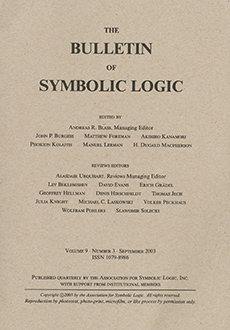Abstract
There are $\Pi_5$ormulas in the language of the Turing degrees, $\mathcal{D}$ with $\leq, \lor$ and $\land$ that define the relations $\mathbf{x}^{\prime\prime} \leq \mathbf{y}^{\prime\prime}, \mathbf{x}^{\prime\prime}=\mathbf{y}^{\prime\prime}$and so $\mathbf{x} \in \mathbf{L}_{2}(\rm{y}) = {\mathbf{x} \geq \mathbf{y}\, \vert \, \mathbf{x}^{\prime\prime}= \mathbf{y}^{\prime\prime}}$ in any jump ideal containing $\mathbf{0}^{\omega}$. There are also $\Sigma_6 $& $\Pi_6$ and $\Pi_8$ formulas that define the relations $\mathbb{w} = \mathbb{x}^{\prime\prime}$ and $\mathbb{w} = \mathbb{x}^{\prime}$, respectively, in any such ideal $\mathcal{I}$. In the language with just $\leq$ the quantifier complexity of each of these definitions increases by one. On the other hand, no $\Pi_2$ or $\Sigma_2$ formula in the language with just $\leq$ defines $\mathbf{L}_2$ or $\mathbf{x} \in \mathbf{L}_2(\mathbf{y})$. Our arguments and constructions are purely degree theoretic without any appeals to absoluteness considerations, set theoretic methods or coding of models of arithmetic. As a corollary, we see that every automorphism of $\mathcal{I}$ is fixed on every degree above $\mathbf{0}^{\prime\prime}$ and every relation on I that is invariant under double jump or joining with $\mathbf{0}^{\prime\prime}$ is definable over I if and only if it is definable in second order arithmetic with set quantification ranging over sets whose degrees are in $\mathcal{I}$ Similar direct coding arguments show that every hyperjump ideal I is rigid and biinterpretable with second order arithmetic with set quantification ranging over sets with hyperdegrees in $\mathcal{I}$. Analogous results hold for various coarser degree structures.
Citation
Richard A. Shore. "Local definitions in degree structures: the Turing jump, hyperdegrees and beyond." Bull. Symbolic Logic 13 (2) 226 - 239, June 2007. https://doi.org/10.2178/bsl/1185803806
Information





